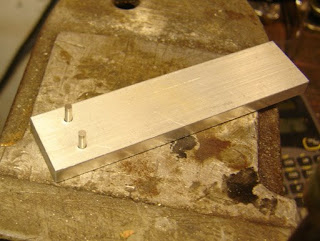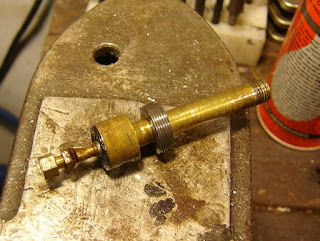
I started with a piece of 1" diam. drill rod.

Cut off a 5.75" piece. Didn't weigh it. It was easily over a pound of steel.

With the steady rest in place, I faced both ends.

Spotted one end with a center drill.

Note to self: Drilling a 5" hole in a piece of solid steel is really a drag. It would take one heck of a drill press to do this. The lathe spins the workpiece, the tailstock holds the drill bit stationary.

The swarf was piling up.

This was the happiest moment of my day. A 0.250" hole--and it looks on center!

The 0.250" hole will allow a .22 cal pellet to pass through. Now I need to open up one end to fit over the muzzle. A quick call this morning to Joe reminded me that there are several screw holes for the front sight base that I need to cover. Need the bore to be a bit over 2.400" long. The Air Magnum's barrel, by the way, is 0.5905"diameter. (15 mm) Great, that's huge. I don't have a drill bit that large that will fit in the tailstock. I started to drill with a short 1/2" drill bit.

More swarf. I drilled the half inch hole 2.80" into the end.
Then, full stop. I didn't have a 15 mm drill bit and I didn't have a boring bar long enough. This is the fun part of machining--you often need to make tools to use your tools. Yep. Whee!

A not-so-quick side project: a boring bar. Grabbed a piece of 0.250" drill rod from the pile and cut a piece about 4" long.

Faced both ends. I would have done some layout and actually done some measurement, but I was burning daylight. A quick trip to Kromhard Twist Drill Company netted me a small boring bar cutting insert.

I eyeballed the insert's base angle and hand filed it into the end of the drill rod.

What's the worst that could happen? Not shown: I laid the insert into the notch, spotted the center of the hole for the fixing screw, consulted a tapping chart, drilled the tap clearance hole with a #47 drill bit, hand tapped the hole to 3-48, heated the bar to cherry red with a torch , quenched it, and I was in business. No, wait. I don't have a boring bar HOLDER in this size. Gotta make another tool to use the tool.

This is a really handy adapter. It threads directly to the Taig lathe's headstock, and allows attachment of a Jacobs chuck.

Here.

I decided to modify an existing tool post to hold the boring bar. I know the boring bar is 0.25" diam. and half of that is 0.125". I dialed out the caliper to a slightly larger number. (Didn't want the edge of the 0.25" hole to come though the side of the holder.) Also had to make sure I didn't drill into the tool post anchor bolt in the center. Settled on 0.150". Set one jaw of the caliper against the aluminum tool post and scratched a reference line. I'll line up the center of my 0.25" hole on this line.

Squared up the tool post on the lathe's cross-slide and bolted it down. Chucked a center drill into the Jacob's chuck, aligned with my scored line, and spotted the hole.

Drilled through with a 0.125" bit...

Followed by a 0.25" bit. I followed this with a chucking reamer to make sure the hole was round and to the correct size.

Spotted 2 holes for 8-32 set screws. Tapping drill #29.

Ran the plug tap in by hand. Lots of cutting oil.

OK, I blued the boring bar.

Back to work. For eyeballing all the angles, the bar worked just fine.

You need a clearance hole for the boring bar to work. Rotated the bar in the holder to get the cutting edge on center. Snugged down the set screws. I used a lot of cutting oil. I bored the hole to just over 0.595". A couple high speed passes just kissing the surface left a nice interior finish.

When I pulled the piece from the lathe, I was astonished to find it still weighed 13.4 oz. I don't think Buddy Joe had that kind of weight in mind. So, chop. Cut the front end off. Now it's 4.80" OAL and down to 7.62 oz.

I need a metal cutting bandsaw.


Faced the end off using another tool I made a few days ago...

Used the boring bar again to make some cuts into the muzzle end of the weight.

Decided to try out the new live center. Just took a passing cut.

Back to the steady rest again to minimize deflection. To cut a taper on the rear of the brake, I set up the compound slide.

Picked an angle and started with some very light cuts.


Even the light cuts were pulling the workpiece out of the 3-jaw chuck. I switched to the steel 4-jaw, got out a dial indicator, centered the workpiece.

Slowly cutting the taper.

Another view.
More soon...






















